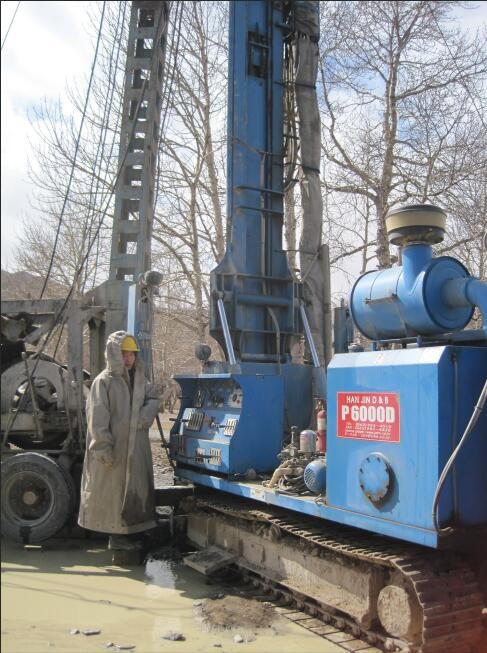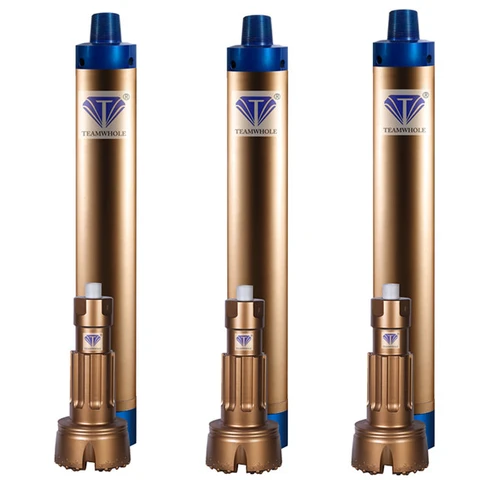Introduction

Understanding the average cost of water well drilling is crucial for making informed decisions. Factors such as the well type, regional variances, and additional expenses can all impact the overall cost. Budgeting for well drilling is essential to ensure the project stays within financial constraints and delivers reliable water access for years.
Understanding the Average Water Well Drilling Cost
The average water well drilling cost can vary depending on several factors, including the depth of the well, equipment and material expenses, labor costs, and permit fees. It's important to clearly understand these components to budget for a successful drilling project accurately.
Factors Affecting Water Well Drilling Costs
Several factors come into play when determining the water well's cost. Understanding these factors can help you budget effectively and prepare for potential expenses:
- Depth and Diameter of the Well: Deeper and wider wells require more time, materials, and labor, leading to higher costs.
- Geological Conditions: Drilling through hard rock or dense soil is more challenging and time-consuming than drilling through softer materials, impacting the project cost.
- Accessibility: Difficulty accessing the drilling site due to location or terrain can necessitate specialized equipment or additional labor, increasing the overall cost.
- Local Regulations: Permitting and licensing requirements vary by region and can add to the final cost.
- Labor Availability and Rates: Experienced well drillers may charge more for their services, especially in areas with limited qualified professionals.
By carefully considering these factors, you can make informed decisions and be better prepared for the financial aspects of your water well drilling project.
Importance of Budgeting for Well Drilling
Planning a well drilling project is an exciting step towards securing a reliable water source. However, creating a comprehensive budget is crucial before breaking ground to avoid financial surprises and ensure project success. Here are the key advantages of establishing a well-defined budget:
- Mitigate Risk: A well-defined budget anticipates potential costs and helps you prepare for unexpected expenses. This financial cushion minimizes stress and allows you to navigate unforeseen circumstances without jeopardizing the project's completion.
- Informed Decision-Making: By understanding your budget limitations, you can make informed choices regarding materials, equipment, and service providers. This empowers you to prioritize essential elements while potentially finding cost-effective alternatives for secondary considerations.
- Project Scope Clarity: Defining your budget compels you to define the project scope clearly. This involves assessing property size, well depth requirements, and potential geological complexities. This clarity ensures you accurately estimate costs and avoid overspending.
By creating a realistic and detailed budget, you can approach your well-drilling project with confidence, ensuring a smooth and successful journey toward securing a reliable water source.
Determining the Scope of the Project

When considering the average water well drilling cost, assessing your water needs is crucial. Understanding your daily water consumption will help determine the size and depth of the well required for residential or commercial use. This initial assessment will be key in budgeting for your well drilling project.
Assessing Water Needs
Selecting the appropriate well type is crucial for a successful well drilling project. This decision hinges on several factors, including:
- Geological composition: The type of soil and rock formations in your location plays a significant role. Softer soil is better suited for shallow wells, while harder, compacted soil may necessitate a deeper well.
- Water table depth: The depth of the water table, the underground layer saturated with water, determines the well depth needed to access a reliable water source.
Understanding these factors empowers you to select the most suitable well type for your needs. However, consulting with experts like Tianhe is vital for navigating the complexities of well drilling and making informed decisions.
Choosing the Right Well Type
Consulting with Tianhe for expert advice is essential to making informed decisions about your well drilling project. Their geology, hydrology, and engineering expertise will provide valuable insights into factors such as soil composition, aquifer characteristics, and potential environmental impacts. With their guidance, you can avoid unnecessary expenses and ensure efficient resource utilization.
Consulting with Tianhe for Expert Advice
By carefully assessing water needs, choosing the right well type, and seeking expert advice from Tianhe, you'll be on track to effectively manage your water well drilling cost while ensuring long-term access to clean water resources for residential and commercial purposes.
After carefully assessing your water needs and choosing the right well type, consulting with Tianhe for expert advice can provide valuable insights into the best drilling methods and techniques for your specific situation. By leveraging Tianhe's expertise, you can avoid costly mistakes and ensure that your water well drilling project stays within budget while delivering reliable access to clean water. With their guidance, you can make informed decisions that will benefit residential and commercial properties for years.
Understanding the Cost Components

When considering the average water well drilling cost, it's essential to understand the various cost components involved. Equipment and material costs play a significant role in determining the overall expense of well drilling. These include the cost of drilling rigs, casing materials, pumps, and other equipment for the project. Understanding these costs is crucial for budgeting and planning.
1. Equipment and Material Costs
The equipment and material costs for water well drilling can vary depending on factors such as the depth of the well, geological conditions, and the type of well being drilled. Working with a reputable supplier who can provide high-quality materials at a reasonable cost is important. Additionally, choosing the right equipment for the specific project requirements can help manage expenses effectively.
When considering equipment and material costs for water well drilling, it's important to factor in the potential impact of unforeseen circumstances. Geological conditions can greatly affect the type and amount of materials needed for the project, so a contingency plan can help mitigate any additional expenses. By working closely with suppliers who understand the unique challenges of drilling in different geological formations, you can ensure that you have access to the right materials when needed.
2. Labor Costs
Labor costs are another significant component of water well drilling expenses. Skilled labor is required for tasks such as operating drilling machinery, installing casing and pumps, and conducting tests to ensure the well's proper functioning. The labor force's expertise can impact both efficiency and overall project costs.
Skilled labor is essential for ensuring the water well drilling process is carried out efficiently and effectively. Without skilled workers, there is a risk of errors and delays that can lead to higher project costs. Additionally, experienced labor can offer valuable insights and suggestions to optimize the drilling process, potentially saving time and money in the long run. Therefore, investing in a knowledgeable and proficient labor force is crucial for managing labor costs in water well drilling projects.
3. Permit and Inspection Fees
In addition to equipment and labor costs, permit and inspection fees are part of the overall water well drilling cost near me or any location. Before initiating a drilling project, obtaining all necessary permits from local authorities is crucial to ensure compliance with regulations. Inspection fees may also apply during various project stages to verify adherence to safety standards.
It's important to note that permit and inspection fees can vary depending on the location and the specific requirements of the drilling project. Factors such as the depth of the well, the type of equipment used, and the environmental impact assessment may all play a role in determining the overall cost of permits and inspections. Additionally, some areas may have more stringent regulations in place, leading to higher fees for compliance. It's essential to consider these potential cost variances when budgeting for a water well drilling project.
Exploring Cost Variances

When it comes to water well drilling costs, one key factor to consider is regional variances in drilling costs. Depending on the location, the geological composition of the ground, and the availability of drilling equipment and materials, costs can vary significantly. Researching and understanding these regional differences is essential before budgeting for well drilling.
Regional Variances in Drilling Costs
In some areas, such as regions with rocky terrain or challenging soil conditions, the cost of drilling for water can be higher due to the need for specialized equipment and expertise. On the other hand, areas with softer soil or easier access to groundwater may have lower drilling costs. Understanding these regional variances is crucial for accurately estimating the total cost of your well drilling project.
Differences in Commercial and Residential Well Drilling
Another factor that impacts water well drilling cost is whether it's a commercial or residential project. Commercial well drilling often involves larger-scale operations, deeper wells, and more complex water needs, which can result in higher overall costs than residential projects. It's important to factor in these differences when planning your budget for well drilling.
Factors Impacting Deep Well Drilling Costs
Several factors can significantly impact the cost of drilling a deep well. Considering these factors before your project can help you make informed decisions and budget effectively.
- Well Depth: Deeper wells naturally require more resources. This includes increased labor hours, specialized equipment capable of reaching greater depths, and additional materials like casing and well screens. As a result, the cost per foot drilled generally increases with depth.
- Geological Formations: The type of rock and soil formations encountered during drilling can significantly impact costs. Harder rock formations may require more robust drilling methods and equipment, increasing expenses. Conversely, drilling through softer formations may be faster and require less specialized equipment, reducing costs.
- Groundwater Levels: The depth at which groundwater is readily available also plays a role. Drilling deeper to reach sufficient water levels will increase the overall cost.
By thoroughly assessing these factors and consulting with qualified professionals, you can better understand the potential costs involved in your deep well drilling project.
The depth of the well is a significant factor affecting deep well drilling costs. Deeper wells require more labor, specialized equipment, and additional materials, all contributing to higher overall expenses. Factors such as geological formations and groundwater levels also impact deep well drilling costs, making it essential to thoroughly assess these factors before embarking on a deep well project.
Now that we've explored some key factors impacting water well drilling cost variances, let's consider budgeting for additional pump installation and long-term maintenance expenses.
Budgeting for Additional Expenses

When budgeting for water well drilling costs, it's essential to consider the expenses of pump and installation. The cost of the pump itself can vary depending on the depth and water flow required, while installation costs may also fluctuate based on the complexity of the well system. Investigating these expenses is crucial to ensure a smooth and efficient well drilling process.
Pump and Installation Costs
Pump and installation costs are significant components of water well drilling expenses. The type of pump needed, whether submersible or jet, will impact the overall cost. Additionally, factors such as the depth of the well and accessibility to the drilling site can influence installation expenses. By carefully budgeting for these costs, you can avoid unexpected financial burdens during the drilling process.
When considering pump and installation costs for water well drilling, it's important to factor in the potential need for water treatment and ongoing maintenance expenses. Depending on the water quality in your area, you may need to invest in additional filtration or purification systems to ensure that the water from your well is safe for consumption. These treatment costs can add up, so it's wise to include them in your budget from the outset.
Water Treatment and Maintenance Expenses
After drilling for water, it's important to consider ongoing water treatment and maintenance expenses. Depending on the groundwater quality in your area, you may need to invest in filtration systems or other treatment methods to ensure clean and safe drinking water. Regular maintenance is also crucial for preserving the longevity of your well system, so budgeting for these expenses is key.
Additionally, it's important to factor in the cost of regular water testing to ensure that the treatment methods effectively remove contaminants. Testing for bacteria, nitrates, and other potential pollutants can help identify any issues early on and prevent potential health risks. These ongoing testing expenses should be included in your budget to maintain the safety and quality of your drinking water.
Expected Lifespan and Long-term Financial Planning
Considering the expected lifespan of your water well system is vital when budgeting for additional expenses. By understanding how long your well is projected to last with proper maintenance, you can plan financially for any future repairs or replacements that may be necessary. Long-term financial planning ensures that you're prepared for any potential costs associated with your water well.
Now that we've covered all aspects of budgeting for additional expenses related to water well drilling costs, it's clear that thorough financial planning is essential to ensure a successful and sustainable investment in a reliable water source. By considering all potential costs associated with pump installation, water treatment, maintenance expenses, expected lifespan, and long-term financial planning, you'll be equipped with a comprehensive understanding of what it takes to maintain your water well over time.
Partner with Tianhe for Efficient and Cost-effective Solutions

When it comes to well drilling investments, it's crucial to be well-informed about the costs involved. By understanding the average water well drilling cost and the factors that affect it, you can make smarter decisions for your project. Partnering with Tianhe for efficient and cost-effective solutions ensures you get the best value for your investment. Budgeting for long-term water well maintenance and care will help you avoid unexpected expenses.
Making Informed Decisions for Well Drilling Investments
Understanding the intricacies of water well drilling costs is essential for making informed decisions about your investment. You can plan your budget by carefully considering equipment and material costs, labor costs, permit fees, and regional variances in drilling costs.
Tianhe offers expert advice and guidance on all aspects of well drilling. They help you choose the right well type and navigate potential cost variances. Their expertise ensures that your project is executed efficiently, saving you time and money.
Tianhe's commitment to providing efficient, cost-effective solutions doesn't end with the initial drilling process. They also offer long-term maintenance and care plans for your water well, ensuring it functions optimally for years. By budgeting for ongoing maintenance, you can avoid costly repairs and extend the lifespan of your well, ultimately saving you money in the long run. With Tianhe's guidance, you can choose the best maintenance plan for your specific well type and usage needs.
Budgeting for Long-term Water Well Maintenance and Care
Budgeting isn't just about initial drilling costs; it's also about planning for long-term maintenance and care of your water well. By factoring in expenses such as pump installation, water treatment, and expected lifespan, you can ensure that your investment remains sustainable over time. In addition to these costs, it's important to budget for regular inspections and potential repairs to keep your water well functioning at its best. By setting aside funds for routine maintenance, you can prevent more costly issues from arising and extend your well's life.

